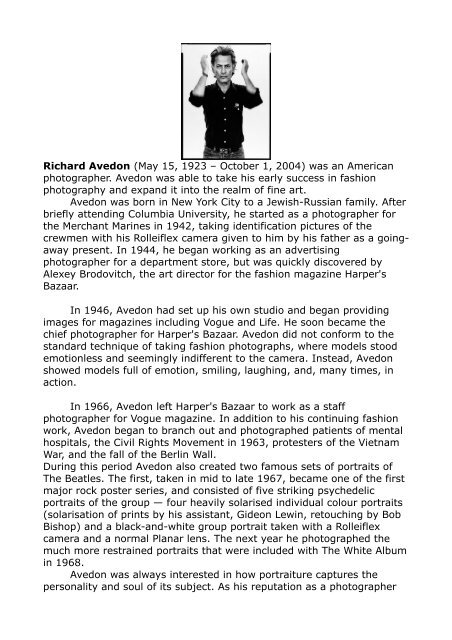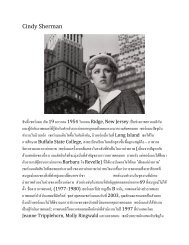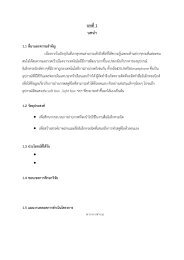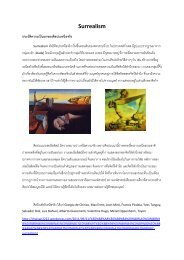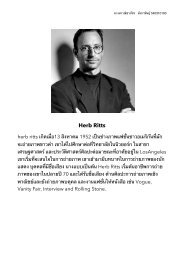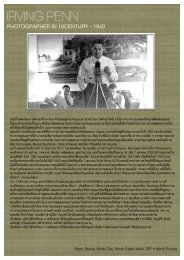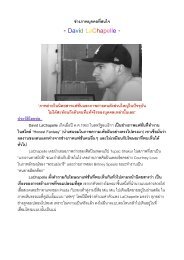Richard Avedon (May 15, 1923 â October 1, 2004) was an American ...
Richard Avedon (May 15, 1923 â October 1, 2004) was an American ...
Richard Avedon (May 15, 1923 â October 1, 2004) was an American ...
Create successful ePaper yourself
Turn your PDF publications into a flip-book with our unique Google optimized e-Paper software.
<strong>Richard</strong> <strong>Avedon</strong> (<strong>May</strong> <strong>15</strong>, <strong>1923</strong> – <strong>October</strong> 1, <strong>2004</strong>) <strong>was</strong> <strong>an</strong> Americ<strong>an</strong>photographer. <strong>Avedon</strong> <strong>was</strong> able to take his early success in fashionphotography <strong>an</strong>d exp<strong>an</strong>d it into the realm of fine art.<strong>Avedon</strong> <strong>was</strong> born in New York City to a Jewish-Russi<strong>an</strong> family. Afterbriefly attending Columbia University, he started as a photographer forthe Merch<strong>an</strong>t Marines in 1942, taking identification pictures of thecrewmen with his Rolleiflex camera given to him by his father as a goingawaypresent. In 1944, he beg<strong>an</strong> working as <strong>an</strong> advertisingphotographer for a department store, but <strong>was</strong> quickly discovered byAlexey Brodovitch, the art director for the fashion magazine Harper'sBazaar.In 1946, <strong>Avedon</strong> had set up his own studio <strong>an</strong>d beg<strong>an</strong> providingimages for magazines including Vogue <strong>an</strong>d Life. He soon became thechief photographer for Harper's Bazaar. <strong>Avedon</strong> did not conform to thest<strong>an</strong>dard technique of taking fashion photographs, where models stoodemotionless <strong>an</strong>d seemingly indifferent to the camera. Instead, <strong>Avedon</strong>showed models full of emotion, smiling, laughing, <strong>an</strong>d, m<strong>an</strong>y times, inaction.In 1966, <strong>Avedon</strong> left Harper's Bazaar to work as a staffphotographer for Vogue magazine. In addition to his continuing fashionwork, <strong>Avedon</strong> beg<strong>an</strong> to br<strong>an</strong>ch out <strong>an</strong>d photographed patients of mentalhospitals, the Civil Rights Movement in 1963, protesters of the VietnamWar, <strong>an</strong>d the fall of the Berlin Wall.During this period <strong>Avedon</strong> also created two famous sets of portraits ofThe Beatles. The first, taken in mid to late 1967, became one of the firstmajor rock poster series, <strong>an</strong>d consisted of five striking psychedelicportraits of the group — four heavily solarised individual colour portraits(solarisation of prints by his assist<strong>an</strong>t, Gideon Lewin, retouching by BobBishop) <strong>an</strong>d a black-<strong>an</strong>d-white group portrait taken with a Rolleiflexcamera <strong>an</strong>d a normal Pl<strong>an</strong>ar lens. The next year he photographed themuch more restrained portraits that were included with The White Albumin 1968.<strong>Avedon</strong> <strong>was</strong> always interested in how portraiture captures thepersonality <strong>an</strong>d soul of its subject. As his reputation as a photographer
ecame widely known, he brought in m<strong>an</strong>y famous faces to his studio<strong>an</strong>d photographed them with a large-format 8x10 view camera. Hisportraits are easily distinguished by their minimalist style, where theperson is looking squarely in the camera, posed in front of a sheer whitebackground. Among the m<strong>an</strong>y rock b<strong>an</strong>ds photographed by <strong>Avedon</strong>, in1973 he shot Electric Light Orchestra with all the members exposingtheir bellybuttons for recording, On the Third Day.He is also distinguished by his large prints, sometimes measuring overthree feet in height. His large-format portrait work of drifters, miners,cowboys <strong>an</strong>d others from the western United States became a bestsellingbook <strong>an</strong>d traveling exhibit entitled In the Americ<strong>an</strong> West, <strong>an</strong>d isregarded as <strong>an</strong> import<strong>an</strong>t hallmark in 20th Century portrait photography,<strong>an</strong>d by some as <strong>Avedon</strong>'s magnum opus. Commissioned by the AmonCarter Museum in Fort Worth, Texas, it <strong>was</strong> a six-year project <strong>Avedon</strong>embarked on in 1979, that produced 125 portraits of people in theAmeric<strong>an</strong> west who caught <strong>Avedon</strong>'s eye.<strong>Avedon</strong> <strong>was</strong> drawn to working people such as miners <strong>an</strong>d oil fieldworkers in their soiled work clothes, unemployed drifters, <strong>an</strong>d teenagersgrowing up in the West circa 1979-84. When first published <strong>an</strong>dexhibited, In the Americ<strong>an</strong> West <strong>was</strong> criticized for showing what someconsidered to be a disparaging view of America. <strong>Avedon</strong> <strong>was</strong> also laudedfor treating his subjects with the attention <strong>an</strong>d dignity usually reservedfor the politically powerful <strong>an</strong>d celebrities. Laura Wilson served as<strong>Avedon</strong>'s assist<strong>an</strong>t during the creation of In the Americ<strong>an</strong> West <strong>an</strong>d in2003 published a photo book documenting the experiences, <strong>Avedon</strong> atWork, In the Americ<strong>an</strong> West.<strong>Avedon</strong> became the first staff photographer for The New Yorker in1992. He has won m<strong>an</strong>y awards for his photography, including theInternational Center of Photography Master of Photography Award in1993, the Prix Nadar in 1994 for his photobook Evidence, <strong>an</strong>d the RoyalPhotographic Society <strong>15</strong>0th Anniversary Medal in 2003. In 1944,<strong>Avedon</strong> married Dorcas Nowell, who later became a model <strong>an</strong>d <strong>was</strong>known professionally as Doe <strong>Avedon</strong>. Nowell <strong>an</strong>d <strong>Avedon</strong> divorced afterfive years of marriage.In 1951, he married Evelyn Fr<strong>an</strong>klin; their marriage produced oneson, John. <strong>Avedon</strong> <strong>an</strong>d Fr<strong>an</strong>klin also later divorced.Martial arts movie star Loren <strong>Avedon</strong> is the nephew of <strong>Richard</strong> <strong>Avedon</strong>.On <strong>October</strong> 1, <strong>2004</strong>, he suffered a brain hemorrhage in S<strong>an</strong> Antonio,Texas while shooting <strong>an</strong> assignment for The New Yorker. At the time ofhis death, <strong>Avedon</strong> <strong>was</strong> working on a new project titled On Democracy tofocus on the run-up to the <strong>2004</strong> U.S. presidential election.Hollywood presented a fictional account of his early career in the1957 musical Funny Face, starring Fred Astaire as the fashionphotographer "Dick Avery." <strong>Avedon</strong> supplied some of the stillphotographs used in the production, including its most famous singleimage: <strong>an</strong> intentionally overexposed close-up of Audrey Hepburn's face
in which only her famous features - her eyes, her eyebrows, <strong>an</strong>d hermouth - are visible.Hepburn <strong>was</strong> <strong>Avedon</strong>'s muse in the 1950s <strong>an</strong>d 60s, going as far tosay "I am, <strong>an</strong>d forever will be, devastated by the gift of Audrey Hepburnbefore my camera. I c<strong>an</strong>not lift her to greater heights. She is alreadythere. I c<strong>an</strong> only record. I c<strong>an</strong>not interpret her. There is no going furtherth<strong>an</strong> who she is. She has achieved in herself her ultimate portrait."Erwin Blumenfeld <strong>was</strong> a renowned photographer whose work is situated between1930 <strong>an</strong>d 1969. He <strong>was</strong> born in Berlin on 26 J<strong>an</strong>uary 1897, moved to Holl<strong>an</strong>d late1918, <strong>an</strong>d started a professional career in photography in 1934. He moved toFr<strong>an</strong>ce in 1936. From 1937 to 1939, he published in <strong>an</strong>d Harper's Bazaar. Whenthe Second World War broke out, he <strong>was</strong> interned in French camps as <strong>an</strong> alien, but<strong>was</strong> eventually allowed to leave for New York in 1941. He became a US citizen in1946. His more personal work is in black <strong>an</strong>d white; his commercial work in fashion,much for Vogue <strong>an</strong>d Harper's Bazaar, is mostly in color. In both media he <strong>was</strong> agreat innovator. In black <strong>an</strong>d white he did all his work personally in the dark room.In color he drew on his extensive background in classical <strong>an</strong>d modern painting. Hemarried Lena Citroen in Holl<strong>an</strong>d in 1921 <strong>an</strong>d had three children there: Lisette,Henry Alex<strong>an</strong>der <strong>an</strong>d Fr<strong>an</strong>k Yorick. He died in Rome on July 4th, 1969.For details of his life one should read his picaresque autobiography, which he wrotein Germ<strong>an</strong> <strong>an</strong>d on which he worked from 1955 till 1969. It has been published inGerm<strong>an</strong> under the title: Einbildungsrom<strong>an</strong>, Eichborn Verlag, 1998. It also has comeout in English under the title: Eye to I, Thames <strong>an</strong>d Hudson, 1999. It <strong>was</strong> firstpublished in French under the title: Jadis et Daguerre, Robert Laffont, 1975, with are-edition by Editions de la Martinière, 1996. It also has come out in Dutch:Spiegelbeeld, Uitgeverij de Harmonie, 1980. There were several earlier Germ<strong>an</strong>editions under the title: Durch tausendjährige Zeit.
Peter Lindbergh Biography1944 Born on the Polish border of East Germ<strong>an</strong>y1973 Completed two year apprenticeship with photographer, H<strong>an</strong>s Lux1978S tern Magazine published his first fashion series of photographs; moves to Paris.


